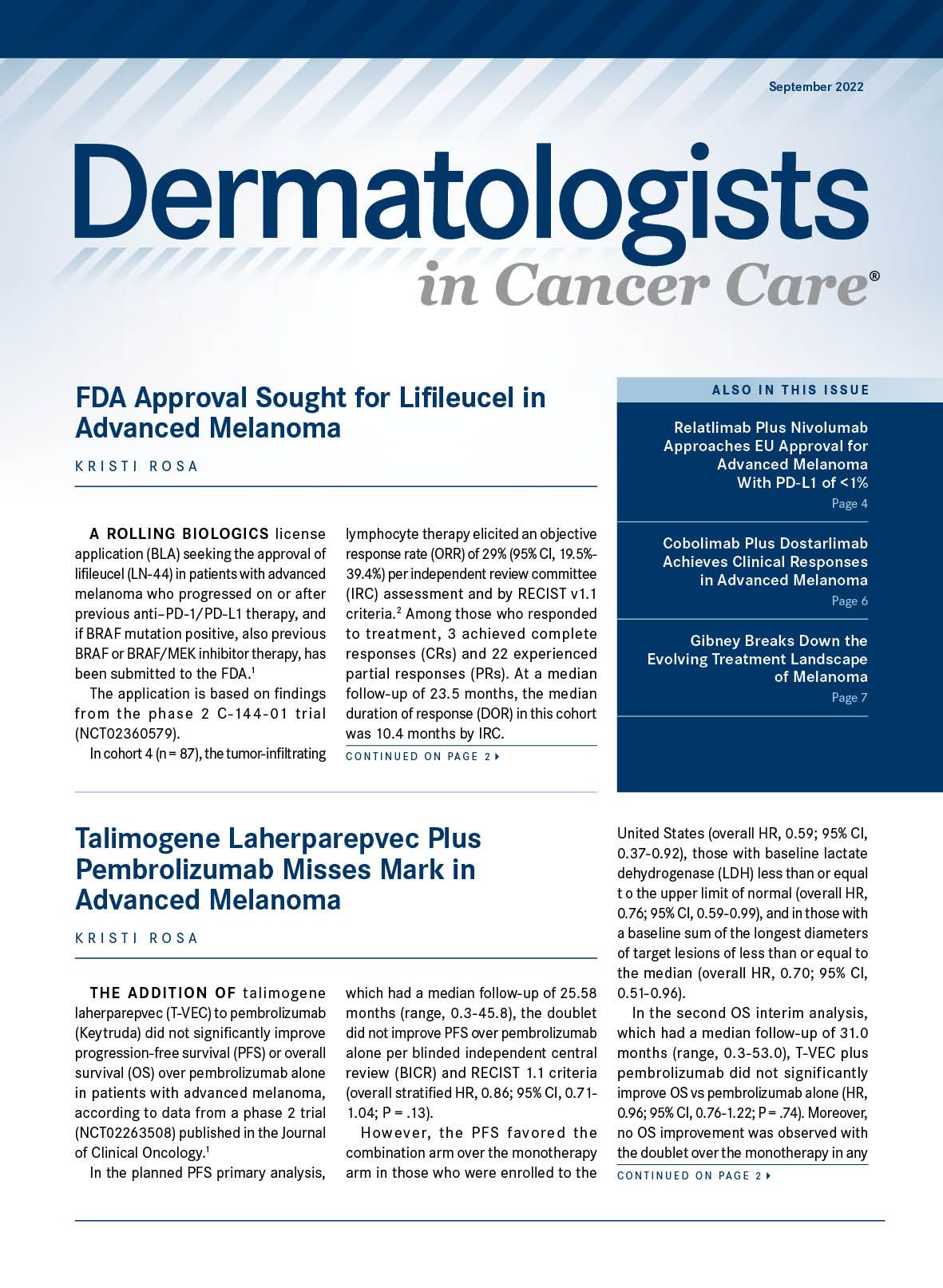Talimogene Laherparepvec Plus Pembrolizumab Misses Mark in Advanced Melanoma
The addition of talimogene laherparepvec to pembrolizumab did not significantly improve progression-free survival or overall survival over pembrolizumab alone in patients with advanced melanoma.
Jason A. Chesney, MD, PhD

The addition of talimogene laherparepvec (T-VEC) to pembrolizumab (Keytruda) did not significantly improve progression-free survival (PFS) or overall survival (OS) over pembrolizumab alone in patients with advanced melanoma, according to data from a phase 2 trial (NCT02263508) published in the Journal of Clinical Oncology.1
In the planned PFS primary analysis, which had a median follow-up of 25.58 months (range, 0.3-45.8), the doublet did not improve PFS over pembrolizumab alone per blinded independent central review (BICR) and RECIST 1.1 criteria (overall stratified HR, 0.86; 95% CI, 0.71-1.04; P = .13).
However, the PFS favored the combination arm over the monotherapy arm in those who were enrolled to the United States (overall HR, 0.59; 95% CI, 0.37-0.92), those with baseline lactate dehydrogenase (LDH) less than or equal t o the upper limit of normal (overall HR, 0.76; 95% CI, 0.59-0.99), and in those with a baseline sum of the longest diameters of target lesions of less than or equal to the median (overall HR, 0.70; 95% CI, 0.51-0.96).
In the second OS interim analysis, which had a median follow-up of 31.0 months (range, 0.3-53.0), T-VEC plus pembrolizumab did not significantly improve OS vs pembrolizumab alone (HR, 0.96; 95% CI, 0.76-1.22; P = .74). Moreover, no OS improvement was observed with the doublet over the monotherapy in any of the predefined subgroups.
“There is a continuing unmet need in the field for combination strategies to improve the efficacy of currently available therapies without added toxicities,” Jason A. Chesney, MD, PhD, of the University of Louisville School of Medicine, and colleagues, wrote in the paper. “Although the combination of T-VEC [and] pembrolizumab did not result in OS benefit compared with placebo [and] pembrolizumab in the frontline treatment of advanced melanoma, this combination is still under active investigation in patients who are refractory to anti–PD-1 inhibitor therapy for melanoma and other tumor types.”
T-VEC is an oncolytic viral intratumoral therapy designed to produce granulocyte-macrophage colony-stimulating factor. When combined with pembrolizumab, it is hypothesized that T-VEC may have the potential to overcome immunotherapy failure.
Data from the single-arm, phase 1b MASTERKEY-265 trial (NCT02263508) showed that T-VEC plus pembrolizumab elicited an objective response rate (ORR) of 62%, which included a complete response rate (CRR) of 43%, in 21 patients with advanced melanoma.2 The combination was also found to be well tolerated, with no dose-limiting toxicities reported.
Based on these data, investigators launched the randomized, double-blind, placebo-controlled, multicenter, international phase 3 trial, which enrolled those with histologically confirmed stage IIIB to IV M1c, unresectable melanoma. To be eligible, patients were required to be at least 18 years of age, have an ECOG performance status of 0 or 1, and at least 1 visceral or nodal/soft tissue melanoma lesion that could be measured in at least 1 dimension and for which the longest diameter was at least 10 mm.
If patients had active untreated brain metastases or primary uveal or mucosal melanoma, or if they previously received T-VEC or any other oncolytic viruses, previous PD-1/PD-L1/PD-L2 agents, previous tumor vaccine in the neoadjuvant setting, or had a history of autoimmune diseases, they were excluded.
Study participants (n = 692) were randomly assigned 1:1 to receive the combination of T-VEC and pembrolizumab (n = 346) or placebo plus pembrolizumab (n = 346). T-VEC/placebo was given via intratumor injection once at 106 PFU/mL for up to 4 mL on day 1 of week 0, followed by up to 4 mL of 108 PFU/mL on day 1 of week 3, and once every 2 weeks until the fifth injection at week 9. Every 3 weeks thereafter, T-VEC plus placebo was then given synchronously with pembrolizumab, which was administered at 200 mg once every 3 weeks.
PFS per modified RECIST (mRECIST) v1.1 criteria and BICR and OS served as the dual primary end points of the trial. Important secondary end points comprised CRR, PFS per modified immune-related response criteria (irRC)–RECIST and BICR, and OS in those with stage IIIB to IVM1b disease.
Other end points included ORR, best overall response, durable response rate (DRR), duration of response, and disease control rate per BICR and both mRECIST v1.1 and modified irRC-RECIST criteria, and safety.
Baseline patient characteristics were noted to be balanced between the treatment arms. Across the arms, the median age was 64 years (range, 19-94). In the investigative and control arms, most patients were White (94.5% vs 96.8%, respectively), had an ECOG performance of 0 (74.9% vs 72.0%), were enrolled in a non-US region (74.9% vs 79.5%), had negative BRAF mutational status (61.0% vs 62.1%), had a baseline LDH ≤ ULN (61.8% vs 69.7%), were PD-L1 positive at baseline (66.8% vs 63.0%), and have IVM1c disease (41.9% vs 41.3%).
Additional data from the primary analysis showed that the ORR achieved with the doublet was 48.6% (95% CI, 43.3%-53.8%) by BICR and per RECIST v1.1 criteria; the CRR was 17.9% (95% CI, 13.9%-22.0%) and the DRR was 42.2% (95% CI, 37.0%-47.4%). The median DOR was 43.7 months (95% CI–not estimable [NE]). In the monotherapy arm, the ORR was 41.3% (95% CI, 36.1%-45.5%), the CRR was 11.6% (95% CI, 8.2%-14.9%), and the DRR was 34.1% (95% CI, 29.1%-39.1%). The median DOR was not NE with pembrolizumab alone.
Regarding safety, treatment-related toxicities were reported by 88.4% of those who were given T-VEC plus pembrolizumab vs 74.6% of those given pembrolizumab alone. The most common adverse effects (AEs) reported in the investigative and control arms were pyrexia (35.1% vs 5.0%, respectively) and fatigue (31.3% vs 22.2%).
Grade 3 or higher treatment-related AEs were experienced by 20.3% of those in the doublet arm and 15.7% of those in the monotherapy arm. Five patients on the investigative arm and 42 patients on the control arm had a fatal AE. Five of these effects were determined to be related to treatment. In the T-VEC/pembrolizumab arm, 1 patient experienced atypical pneumonia, 1 had cardiac arrest, and 1 had delirium, and 1 had pulmonary sepsis; in the pembrolizumab-alone arm, 1 patient had respiratory failure.
Any-grade immune-related AEs (irAEs) were reported in 27.5% of patients who received the doublet and 24.8% of those who were given the monotherapy. The most common irAEs in the investigative and control arms were hypothyroidism (12.5% vs 13.4%) and hyperthyroidism (5.8% vs 5.0%).
References
- Chesney JA, Ribas A, Long GV, et al. Randomized, double-blind, placebo-controlled, global phase III trial of talimogene laherparepvec combined with pembrolizumab for advanced melanoma. J Clin Oncol. Published online August 23, 2022. doi:10.1200/JCO.22.00343
- Long G, Dummer R, Johnson D, et al. 429 Long-term analysis of MASTERKEY-265 phase 1b trial of talimogene laherparepvec (T-VEC) plus pembrolizumab in patients with unresectable stage IIIB-IVM1c melanoma. J Immunother Cancer. 2020;8(suppl 3). doi:10.1136/jitc-2020-SITC2020.0429




